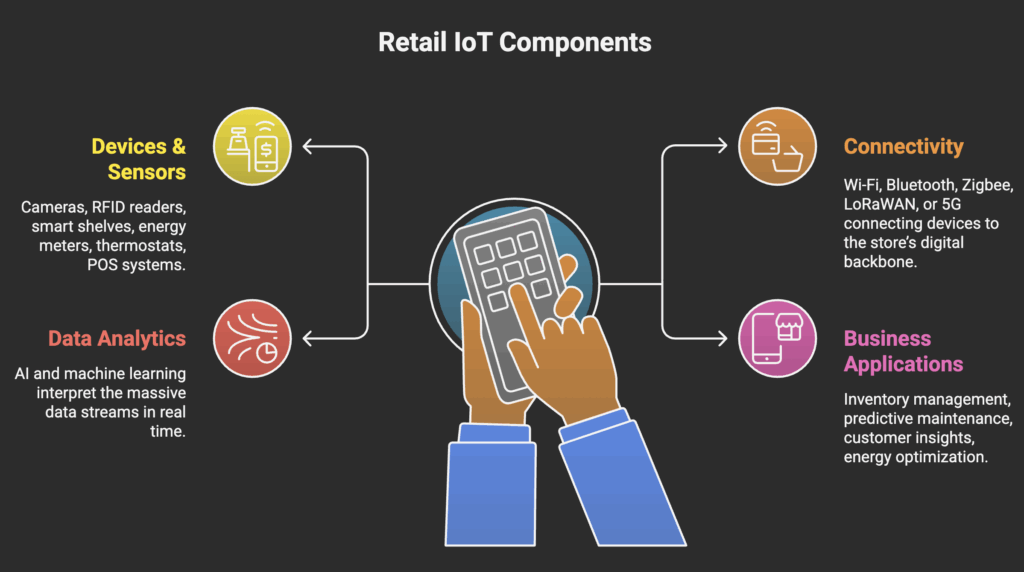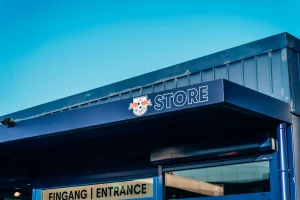The New Era of Connected Retail
Walk into a modern store today, and you may not realize how many invisible technologies are quietly working behind the scenes. From the smart cameras monitoring customer flow to the energy-efficient freezers in a supermarket, and even the interactive digital signage displaying personalized promotions—these are not just isolated tools. They are all part of what the industry now calls Retail IoT.
Retail IoT (Internet of Things in Retail) refers to the network of connected devices, sensors, and systems that work together to enhance operational efficiency, optimize resource utilization, and deliver improved shopping experiences. It is also known as Smart Retail Technology, highlighting how digital systems and IoT converge in modern stores. It is the backbone of the modern Connected Store, where data flows continuously between physical assets, cloud platforms, and AI analytics engines.
Why Retail IoT Matters Today
The retail industry has always been competitive, but today’s challenges are unprecedented:
- Rising operational costs (energy, labor, logistics).
- Shifting customer expectations for convenience and personalization.
- The rapid growth of e-commerce putting pressure on physical stores.
- Increasing demand for sustainability and energy efficiency.
Retail IoT is not just a technology upgrade—it is becoming a strategic necessity. According to Gartner, by 2027, more than 75% of physical retail stores will deploy some form of IoT-enabled solution for monitoring, customer engagement, or operational optimization.
Defining Retail IoT
At its core, Retail IoT = Devices + Connectivity + Data Analytics + Business Applications. In simple terms, this is what people often mean when they talk about IoT in Retail, where physical store assets are linked with digital intelligence.

- Devices & Sensors: Cameras, RFID readers, smart shelves, energy meters, thermostats, POS systems.
- Connectivity: Wi-Fi, Bluetooth, Zigbee, LoRaWAN, or 5G connecting devices to the store’s digital backbone.
- Data Analytics: AI and machine learning interpret the massive data streams in real time.
- Business Applications: Inventory management, predictive maintenance, customer insights, energy optimization.
This integration allows retailers to transform raw data into actionable insights. For example:
- A smart shelf detects that a product is running low → triggers automatic restocking.
- A smart camera analyzes customer movement → optimizes store layout.
- An energy monitor detects abnormal power consumption → alerts maintenance before breakdown.
Key Characteristics of Retail IoT
- Real-Time Visibility
- Retail IoT enables managers to see what’s happening in the store at any moment—stock levels, foot traffic, energy consumption.
- Automation
- Many processes, like replenishment and HVAC adjustments, can be automated based on sensor data.
- Customer-Centric Insights
- Beyond operations, IoT reveals how customers behave: which aisles attract the most traffic, what promotions drive engagement, and when peak hours occur.
- Integration with Cloud & AI
- Cloud platforms allow data aggregation across multiple stores, while AI provides predictive insights for future decision-making. Together, these features empower effective Store Operations Management, from inventory visibility to energy optimization.
Diagram: How Retail IoT Works
--- title: "Retail IoT Ecosystem" --- graph TD %% ===== Styles ===== classDef device fill:#e0f7fa,stroke:#0288d1,stroke-width:1.5,rx:10,ry:10; classDef conn fill:#f1f8e9,stroke:#43a047,stroke-width:1.5,rx:10,ry:10; classDef process fill:#fffde7,stroke:#fbc02d,stroke-width:1.5,rx:10,ry:10; classDef ops fill:#ede7f6,stroke:#5e35b1,stroke-width:1.5,rx:10,ry:10; %% ===== Nodes ===== A["📟 IoT Devices & Sensors"]:::device B["🌐 Connectivity Layer(Wi-Fi / 5G / Zigbee)"]:::conn C["⚡ Data ProcessingEdge & Cloud"]:::process D1["🏬 Store OperationsManagement"]:::ops D2["🛍️ Customer ExperienceOptimization"]:::ops D3["🌱 Energy & ResourceEfficiency"]:::ops %% ===== Flows ===== A --> B B --> C C --> D1 C --> D2 C --> D3
The Evolution of Retail IoT
Retail IoT didn’t appear overnight—it evolved as retailers adopted digital technologies:
- Phase 1: Basic Automation – barcode scanners, POS systems.
- Phase 2: Early IoT – RFID tracking, simple digital signage.
- Phase 3: Connected Store Era – AI-driven analytics, integrated smart devices, cloud-native platforms.
Today, Retail IoT is moving toward predictive and autonomous operations, where AI doesn’t just provide data but actively drives decisions (e.g., adjusting pricing dynamically, preventing equipment failures before they happen).
Applications of Retail IoT
If the first step in understanding Retail IoT is knowing what it is, the second is recognizing where it delivers value. Across retail operations, IoT is no longer a futuristic concept—it’s already being deployed in thousands of stores worldwide. Let’s break down its core applications.
1. Smart Inventory & Supply Chain Management
Inventory mismanagement is one of the most expensive problems in retail. Stockouts frustrate customers and reduce sales, while overstocks waste storage space and increase markdown losses. Retail IoT addresses this by combining smart shelves, RFID, and real-time analytics.
- Smart Shelves & Weight Sensors Shelves embedded with weight sensors or cameras can detect when items are running low and automatically alert staff.
- RFID & Automated Tracking RFID tags provide item-level visibility from warehouse to store shelf, minimizing manual scanning errors.
- Predictive Replenishment AI-driven systems analyze sales velocity, time of day, and seasonal trends to forecast replenishment needs.
👉 Result: Fewer stockouts, reduced manual labor, and a more resilient supply chain.
2. Energy & Facility Management
Retail stores are energy-intensive environments, with lighting, refrigeration, HVAC, and electronic displays running almost continuously. IoT-powered energy monitoring offers granular visibility and automated optimization.
- Smart Energy Meters: Devices track real-time consumption for specific equipment (freezers, lighting, air conditioners).
- HVAC & Lighting Automation: Sensors adjust temperature and lighting based on occupancy and time of day.
- Predictive Maintenance: Vibration and power anomaly detection alert staff before equipment failures occur.
👉 Result: Energy savings of 10–30% are common, alongside reduced downtime and longer equipment lifespan.

3. Enhancing the Customer Experience
Retail IoT is not just about back-end efficiency; it’s also about creating memorable, personalized experiences for customers.
- Foot Traffic & Heatmaps Cameras and sensors track customer movement patterns, allowing stores to optimize layouts and product placement.
- Smart Digital Signage Displays adapt content based on time of day, promotions, or even detected customer demographics (in an anonymized, GDPR-compliant way).
- Connected Fitting Rooms IoT-enabled mirrors suggest complementary products or sizes, bridging physical and digital shopping.
- Queue Management AI monitors checkout lines and prompts staff to open new registers when wait times increase.
👉 Result: Higher conversion rates, increased customer satisfaction, and improved brand perception.
4. Security & Loss Prevention
Shrinkage (theft, fraud, and administrative errors) costs retailers billions annually. IoT enhances loss prevention with intelligent monitoring.
- AI-Powered Surveillance Cameras equipped with AI detect unusual behaviors—like loitering or suspicious movements—in real time.
- Smart Access Control IoT-based locks and entry systems restrict unauthorized access to sensitive areas like stockrooms.
- Asset Tracking High-value items (electronics, jewelry) can be monitored with RFID and geofencing to reduce theft.
👉 Result: Lower shrinkage rates, improved staff accountability, and safer environments for employees and customers.

5. Workforce Optimization
Managing staff efficiently is critical for both cost control and service quality. IoT provides data-driven scheduling and monitoring.
- Staff Location Tracking Wearables or mobile apps help managers see where staff are deployed in real time.
- Task Automation IoT systems assign tasks dynamically, such as restocking alerts sent directly to an employee’s handheld device.
- Performance Insights Data on task completion times and customer interaction can inform training and rewards.
👉 Result: Better productivity, reduced idle time, and a stronger service culture.

Table: Key Applications of Retail IoT
| Area | IoT Technologies | Benefits |
|---|---|---|
| Inventory & Supply Chain | RFID, smart shelves, AI forecasting | Reduce stockouts, optimize replenishment |
| Energy & Facility | Smart meters, HVAC automation, predictive maintenance | Cut energy costs, prevent downtime |
| Customer Experience | Foot traffic analytics, digital signage, connected fitting rooms | Improve layout, personalize promotions |
| Security & Loss Prevention | AI cameras, access control, RFID asset tracking | Reduce shrinkage, enhance safety |
| Workforce Management | Wearables, mobile apps, task automation | Optimize staffing, boost efficiency |
The Big Picture
When integrated together, these applications create a connected store ecosystem where every action—customer entry, product movement, energy consumption—feeds into a continuous feedback loop. AI then interprets this data to deliver recommendations or trigger automatic actions.
For example:
- A smart shelf detects low stock → system checks inventory → triggers a replenishment request → staff receives a mobile alert.
- Foot traffic sensors show a surge at checkout → IoT queue system alerts managers → new registers are opened.
- Energy sensors detect abnormal freezer consumption → predictive maintenance is scheduled before product loss occurs.
This synergy is what makes Retail IoT a strategic enabler rather than just another technology upgrade.
Challenges, ROI, and the Future of Retail IoT
Implementation Challenges
Despite the benefits, adopting Retail IoT is not without obstacles. Retailers considering IoT often face several key challenges:
- High Initial Costs
- Deploying sensors, upgrading network infrastructure, and integrating cloud platforms require significant upfront investment.
- For small retailers, the cost barrier can slow adoption.
- Integration with Legacy Systems
- Many stores still rely on older POS or ERP systems.
- IoT data must integrate seamlessly with these platforms to be useful, which often requires custom middleware or APIs.
- Data Privacy and Security
- IoT systems collect sensitive customer and operational data.
- Compliance with regulations like GDPR, CCPA, and China’s PIPL is mandatory, and retailers must also prevent cyberattacks that target connected devices.
- Operational Complexity
- Rolling out IoT across multiple branches requires consistent standards, staff training, and ongoing maintenance.
- Without strong change management, even the best technology may fail to deliver results.
Measuring ROI in Retail IoT
Decision-makers need to justify investment with measurable results. ROI for Retail IoT usually comes from three primary sources:
- Cost Savings
- Energy consumption reduced by smart meters and automated HVAC (10–30%).
- Labor savings from automated inventory and queue management.
- Reduced losses through theft prevention and predictive maintenance.
- Revenue Growth
- Improved product availability → fewer missed sales opportunities.
- Personalized promotions and layout optimization → higher conversion rates.
- Enhanced customer experience → increased loyalty and repeat visits.
- Risk Reduction
- Compliance with energy and safety standards.
- Reduced downtime of critical equipment.
- Stronger loss prevention programs.
ROI Example Table
| Category | Traditional Store | With Retail IoT | ROI Impact |
|---|---|---|---|
| Energy Costs | High, reactive management | Smart meters & automation | 10–30% savings |
| Inventory Accuracy | Manual counts, error-prone | RFID + smart shelves | 95%+ accuracy |
| Customer Engagement | Generic promotions | Personalized, data-driven offers | Conversion up 10–20% |
| Shrinkage | Industry avg. 1.5–2% of sales | AI surveillance + RFID | Reduction by 20–40% |
| Labor Efficiency | Manual tasks, high idle time | Task automation + smart scheduling | 15–25% labor cost reduction |
👉 Most retailers report full ROI in 12–18 months, with additional long-term competitive advantages.

The Future of Retail IoT
Looking ahead, Retail IoT is moving beyond monitoring into predictive and autonomous operations:
- AI-Driven Predictive Analytics
- Stores won’t just track customer flow; they’ll predict peak times, optimize layouts proactively, and forecast inventory needs with precision.
- Dynamic Pricing & Personalized Offers
- Integrated IoT + AI systems will adjust product pricing or promotions in real time based on demand, competition, and customer profiles.
- Autonomous Stores
- Inspired by Amazon Go, IoT will enable checkout-free stores where sensors and cameras track purchases automatically, and payment is processed seamlessly.
- Sustainability & ESG Goals
- IoT will play a bigger role in helping retailers achieve carbon reduction targets, by monitoring energy, reducing waste, and tracking sustainable supply chains.
Final Thoughts
Retail IoT is more than just connecting devices—it’s about connecting data, people, and business goals.
- For managers, it provides real-time visibility and automation.
- For customers, it creates personalized, frictionless experiences.
- For the business, it drives efficiency, revenue, and resilience.
As retail evolves in the face of e-commerce pressure and rising costs, IoT isn’t just the future—it’s already the present. Those who embrace it early will be the ones setting the standard for Connected Stores of tomorrow.

